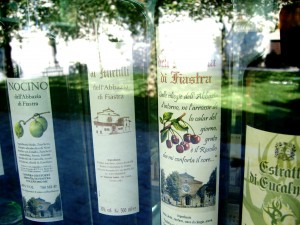So I guess you’ll have gathered the family and I were on holiday in the Marche region last week. One of the cooler places we visited was the Abbadia di Fiastra (that’s its cloister above). This is a romanesque abbey nestled in the middle of an ancient wood, which is now a protected area. Cistercian monks built the place in the 12th Century, reclaimed some of the land for agriculture by changing the course of the river Entogge, and also made use of the nearby forest, of course. You can still buy natural products made on the abbey’s land in the little shop in the visitors’ centre.
There’s an interesting Museum of Peasant Culture at the abbey. Actually it mainly consists of old farm machinery and utensils. This was one of the more interesting exhibit, a seminatrice, or seed sower.
I talked to my friend the farmer about it. He remembers when tractors first came into the region, in the sixties. He remembers sowing and harvesting using machines such as this, pulled by horses or cows. He had heard of the museum, but didn’t think much of the idea.


